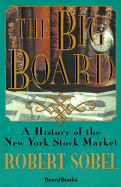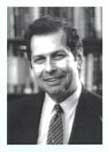
|
The Big Board: A History of the New York Stock Market
By Robert Sobel
2000/05 - Beard Books
1893122662 - Paperback
- Reprint - 395 pp.
US$34.95
This fascinating book shows how the New York securities market, with its promise of great wealth and its equally devastating disappointments, is a vital link in the history of American economic growth.
Publisher Comments
This is the story of Wall Street, the symbol of finance and capitalism in America. It is a drama peopled by such colorful figures as E.H. Harriman and J.P. Morgan among many others. The first history of the New York Stock Market, it traces the development of the institution from its beginnings in the early 18th century to 1965. The author provides a short history of the market that stresses different aspects at different times--how political, social, locational, economic, and financial pressures affected the New York money market.
From the back cover blurb:
This is the story of Wall Street, the symbol of finance capitalism in America.
It is a drama peopled by such colorful figures as Jay Cooke, Jay Gould, J.P.
Morgan, E.H. Harriman and Charles Merrill among many others. The first history
of the New York stock market, it traces the development of the institution from
its beginnings in early America of the 18th century to 1965. It does not purport
to be comprehensive but presents a short history of the market, stressing
different aspects at different times -- how political, social, locational,
economic, and financial pressures affected the New York money market. It shows
how the New York securities market with its promise of great wealth and its just
as devastating disappointments is a vital link in the history of American
economic growth.

Review by Gail Owens Hoelscher
From Turnarounds and Workouts, November 15, 2000
First published in 1965, The Big Board was the first history of the New York stock market. It is a story of people: their foibles and strengths, earnestness and avarice, triumphs and crash-and-burns. It is full of entertaining anecdotes, cocktail-party trivia, and tales of love and hate between companies and investors.
Early investments in North America consisted almost exclusively of land. The few securities holders lived in cities, where informal markets grew, with most trading carried out in the street and in coffeehouses. Banking, insurance, and manufacturing activity increased only after the Revolution. In 1792, 24 prominent New York businessmen, for whom stock and bond trading was only a side business, met under a buttonwood tree on Wall Street and agreed to trade securities on a common commission basis. Five securities were traded; three government bonds and two bank stocks. Trading was carried out at the Tontine Coffee-House in a call market, with the president reading out a list of stocks as brokers traded each in turn.
The first half of the 19th century was heady for security trading in New York. In 1817, the Tontine gave way to the New York Stock and Exchange Board, with a more organized and regulated system. Canal mania, which peaked in the late 1820s, attracted European funds to New York and volume soared to 100 shares a day. Soon, the railroads competed with canals for funding. In the frenzy, reckless investors bought shares in "sheer fabrications of imaginative and dishonest men," leading an economist of the day to lament that "every monied corporation is prima facie injurious to the national wealth, and ought to be looked upon by those who have no money with jealousy and suspicion."
Colorful figures of Wall Street included Jay Gould and Jim Fisk who, in 1869, precipitated one of the worst panics in American financial history by trying to corner the gold market. Almost lynched, the two were hauled into court, where Fisk whined, "A fellow can't have a little innocent fun without everybody raising a halloo and going wild." Then there was Jay Cooke, who invented the national bond drive and, practically unaided, financed the Union effort in the Civil War. In 1873, however, faulty judgment on railroad investments led to the failure of Cooke & Co, and a panic on Wall Street. The NYSE closed for ten days. A journalist wrote: "An hour before its doors were closed, the Bank of England was not more trusted,"
Despite J, P. Morgan's virtual single-handed role in stemming the Knickerbocker Trust panic of 1907, upon his death in 1913, someone wrote, "We verily believe that J. Pierpont Morgan has done more harm in the world than any man who ever lived in it." In the 1950s, Charles Merrill was instrumental in changing this attitude toward Wall Streeters. His firm, Merrill Lynch, derisively known in some quarters as "We, the People" and "The Thundering Herd," brought Wall Street to small investors, traditionally not worth the effort for brokers.
The Big Board closes with this story. Asked by a much younger man what he thought stocks would do next, J,P. Morgan "never hesitated for a moment. He transfixed the neophyte with his sharp glance and replied 'They will fluctuate, young man, they will fluctuate,' And so they will,"
Like the stock
market?, October 1, 2000
Reviewer: Kevin B. Tucker (Amazon.com)
I thought this was an excellent book. If you like the stock market
or history, you will like this book. The author goes back to the
beginnings of the stock market. He spends a lot of time talking
about the 1700 and 1800's, how Wall Street got started. Read how J.
P. Morgan played Allen Greenspan. How he raised 20 million dollars
in 15 minutes! Read about a stock that went from 200 dollars to a
thousand! Read about the big dogs in the market who made and lost
millions. The only thing I didn't like about it was the author
didn't spend as much time on the Great Depression as I would have
liked. That is my only complaint. An excellent book.

 Robert
Sobel was born in 1931 and died in 1999. He was a prolific historian of
American business life, writing or editing more than 50 books and hundreds
of articles and corporate profiles. He was a professor of business at
Hofstra University for 43 years and held a Ph.D. from New York University.
Besides producing books, articles, book reviews, scripts for television
and audiotapes, he was a weekly columnist for Newsday from 1972 to 1988.
At the time of his death he was a contributing editor to Barron's
Magazine. Robert
Sobel was born in 1931 and died in 1999. He was a prolific historian of
American business life, writing or editing more than 50 books and hundreds
of articles and corporate profiles. He was a professor of business at
Hofstra University for 43 years and held a Ph.D. from New York University.
Besides producing books, articles, book reviews, scripts for television
and audiotapes, he was a weekly columnist for Newsday from 1972 to 1988.
At the time of his death he was a contributing editor to Barron's
Magazine.
 Other Beard Books by
Robert Sobel Other Beard Books by
Robert Sobel

|
Foreword |
vii |
|
Preface |
ix |
| 1. |
The European Background |
1 |
| 2. |
Securities in Early America |
14 |
| 3. |
Under English Domination: 1812-1837 |
28 |
| 4. |
The First Age of Rails: 1837-1857 |
47 |
| 5. |
The Fortunes of War: 1857-1865 |
65 |
| 6. |
Consolidation, Expansion, and Panic: 1865-1873 |
81 |
| 7. |
The Rise of Investment Banking: 1873-1884 |
102 |
| 8. |
All Roads Lead to Wall Street: 1884-1896 |
124 |
| 9. |
The Morganization of America: 1896-1903 |
147 |
| 10. |
The End of the Golden Age: 1903-1913 |
174 |
| 11. |
Genealogy of the Giant Bull: 1914-1924 |
206 |
| 12. |
The Triumphant Years of the Giant Bull: 1924-1929 |
235 |
| 13. |
Death of the Giant Bull: 1925-1933 |
262 |
| 14. |
Death and Transfiguration: 1933-1947 |
293 |
| 15. |
The Tardy Boom: 1947-1960 |
321 |
| 16. |
The New Wall Street: 1953-1965 |
346 |
|
Selected Bibliography |
376 |
|
Index |
383 |
|
